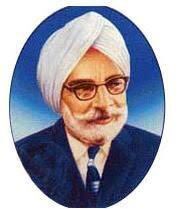Singh, Mohan was born in Mardan (Pakistan). He, however, belonged to the village Dhamial, near Rawalpindi (Pakistan). His father was a doctor in the Civil Hospital. Mohan Singh passed his matriculation examination in 1923. In the same year, he was married to a beautiful girl, Basant. But after four years Basant died and Mohan Singh was involved in an emotional crisis because of this personal tragedy. He had already started participating in the poetic symposia and the tone of his verses was religious and social.
But after the death of his wife, he cried out the anguish in his poetry. He became a romantic poet. In 1929, he married another girl, Surjit Kaur. At that time, after passing the examination of Munshi-Fazal, he was a teacher of Urdu-Persian, in a high school. In 1930, Mohan Singh left the job and joined Oriental College, Lahore, to do M.A. in Persian. From 1933 to 1939, he taught Persian language and literature in Khalsa College, Amritsar. There, Teja Singh, Sant Singh Sekhon, Gurbachan Singh \’Talib\’ became his friends and Mohan Singh studied Blake, Keats, Shelley, Wordsworth, Browning and other English romantic poets.
He was influenced by Oxford Book of English Ballads, and later he wrote ballads in Punjabi. In 1940, he turned to be a lecturer in the Sikh National College, Lahore, but after some time he left the job and started a firm, Hind Publishers, and decided to promote the literary standards of Punjabi publications. In 1939, he had already started his famous literary Punjabi monthly, Panj darya. In 1947, the Partition again disturbed his plans, and he shifted his business to Amritsar. For survival, he faced many odds.
For some reason again he shifted his business to Jullundur, but he could not get success in the competitive market. He closed down the firm and sold out the magazine Panj darya. For some time again he became the teacher in Khalsa College, Patiala, but, later, he was appointed Professor Emeritus in Punjabi Agricultural University, Ludhiana, where he died. Mohan Singh was a major poet of the romantic-progressive movement in the Punjabi language, and his poetic works include Saave pater (1936), Kasumbhra (1939), Adhvate (1944), Kach sach (1950), Aawazan (1954), Vadha vela (1958), Jandre (1964), Jai Mir (1968), Nanakayan (1971), Buhe (1977).
Mohan Singh also translated into Punjabi language Edwin Arnold\’s epic Light of Asia, Greek classic King Oedipus and Novels like Godan, Nirmala, Peengh and some other writings in prose. He wrote another book Gad-pad rachna, which deals with grammar of the language and grammar of the poetry. Mohan Singh was a major force in Punjabi poetry after 1935, and in the next 25 years he influenced the generations of Punjabi poets. He created new norms in Punjabi poetry and created the language of new metaphors.
He is, therefore, considered as the most important Punjabi poet after Waris Shah. Though a romanticist in his earlier poems, he became a moving force under the impact of the Progressive Movement. He was a great lyricist who sang of love and beauty. Under the influence of the National Movement his poetry came to reflect social consciousness and he sang of liberty, equality and fraternity.
References :
1. Encyclopaedia of Indian Literature, 6 Vols., Delhi, 1995.
2. Harbans Singh, Aspect of Punjabi Literature, Ferozepur, 1961.
3. Jasbir Singh Ahluwalia, Tradition and Experiment in Modem Punjabi Poetry, Ferozepur, 1960.
4. —, Punjabi Literature in Perspective, Ludhiana, 1970.
5. Sutinder Singh Noor, Mohan Singh da kav-jagat, Delhi, 1982.
Mohan Singh is hailed as one of the definitive voices behind modern Punjabi romantic poetry—a pioneer who not only molded the language’s literary aesthetics but also infused it with a deeply personal and progressive sensibility.
A Life Shaped by Passion and Tragedy
Born in 1905 in Lyallpur (present-day Pakistan) and rooted in the village of Dhamial near Rawalpindi, Mohan Singh’s early life was marked by both academic promise and personal loss. After excelling in his studies and entering the world of literary symposia, his life took a poignant turn with the death of his first wife, Basant, just four years after their marriage. This devastating personal tragedy transformed his poetic voice—shifting his focus from predominantly religious and social themes to one steeped in the romantic ethos of love, loss, and longing. His verses, laden with emotional intensity, resonated with readers and came to exemplify the modern Punjabi romantic-progressive movement .
Artistic Influences and Literary Evolution
During his tenure at Khalsa College in Amritsar, Mohan Singh immersed himself in a rich cultural milieu alongside literary contemporaries like Teja Singh, Sant Singh Sekhon, and Gurbachan Singh ‘Talib’. His exposure to the works of English Romantic poets—Blake, Keats, Shelley, Wordsworth, Browning—and the ballads encapsulated in collections such as the Oxford Book of English Ballads further enriched his craft. This blending of local Punjab traditions with Western lyrical influences allowed him to craft ballads and longer poetic narratives that retained the timeless beauty of Punjabi folk artistry while introducing fresh, progressive themes. Over the years, his extensive body of work—spanning collections like Saave Pater (1936), Kasumbhra (1939), Adhvate (1944), Kach Sach (1950), Aawazan (1954), Vadha Vela (1958), and later volumes—cemented his reputation as a literary trailblazer .
Legacy and Enduring Impact
Mohan Singh’s poetry is not confined merely to expressions of romantic feeling; it is a narrative of personal transformation that mirrors the broader evolution of Punjabi literature in the 20th century. His innovative approach helped create a space where emotional introspection joined hands with social consciousness, influencing subsequent generations of Punjabi poets. In addition to his original compositions, his efforts in translation—bringing works like Edwin Arnold’s Light of Asia and classical texts into Punjabi—demonstrated his commitment to enriching the literary landscape and making a diverse range of ideas accessible to a wider audience .



